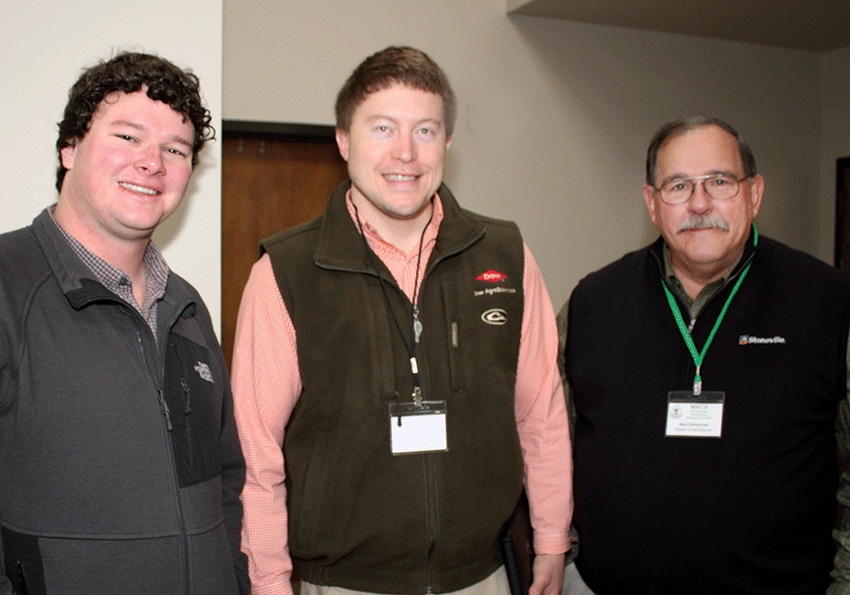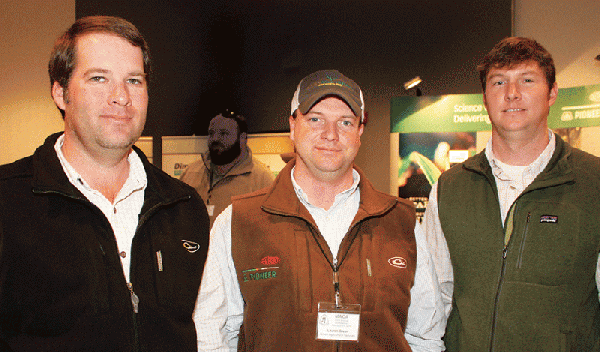
Have you been harvesting 1,400-1,600 pounds of cotton? Or 200 bushel corn? Thanks to improved varieties and better management and production methods, a lot of Delta growers have achieved those lofty yields, says Darrin Dodds.
But he says, many high-producing growers aren’t maintaining soil fertility levels to support those yields.

DARRIN DODDS
DARRIN DODDS“When we’re in a 63-cent cotton market, the first thing some growerss want do is start cutting fertility rates, particularly potash,” he said at the annual meeting of the Mississippi Agricultural Consultants Association.
Dodds, who is Associate Extension/Research professor of plant and soil sciences at Mississippi State University, also spoke on the topic at the annual meeting of the Southern Cotton Ginners Association at Memphis.
“When we look at where we are in terms of yield, we see a yield trend that has been steadily going up, bumping 1,000 to 1,200 pounds,” he says. “USDA numbers show Mississippi with a statewide yield of 1,183 pounds in 2014. Considering that’s an average of Delta, hills, and all different types of land, that was pretty good — only about 20 pounds below 2013, when we set a state record.
“We’ve had two years in a row of tremendous yields, and if we look at the last five years, in four of those years we were knocking on the door of 1,000 pounds average. If we compare that to 10 or 15 years ago, when we were in the 800 pound range, we’ve come along way.
“This is due in large part to improved genetics and better management, and with the downturn in acres, we’re putting our cotton on better ground.”
But Dodds says, “Too many growers who are producing these significantly higher yields are still fertilizing the way they did 15 years ago, when they were in the 800 to 1,000 pound range. They are picking 1,400 to 1,600 pounds of cotton, but they’re still fertilizing for 1,000 pounds.
“Potash deficiency is a particular concern. Be careful cutting your potash rate on cotton — it can come back to bite you.”
Stay current on what’s happening in Mid-South agriculture: Subscribe to Delta Farm Press Daily.
National sales of nitrogen, potash, phosphate have remained relatively level in recent years, he says, “and I suspect that’s the case for Mississippi. In many cases we’re still fertilizing for year 2000 yields, but today’s yields are much higher, and the result is we’re mining some of these fertility levels.”
Nutrient uptake data from North Carolina State University shows a 1,000 pound cotton crop (seed and lint) taking up 150 pounds of potash, Dodds says. “Our crop is taking up 150 to 160 pounds of potash, but typically we’re applying only 90 pounds.
Mining soils of nutrients

JOSEPH DEAN, from left, Dean Ag Services, Cleveland, Miss.; Lauren Green, Green Ag Services, Greenwood, Miss.; and Ty Edwards, Edwards Ag Consulting, Water Valley, Miss., were among consultants at the conference.
JOSEPH DEAN, from left, Dean Ag Services, Cleveland, Miss.; Lauren Green, Green Ag Services, Greenwood, Miss.; and Ty Edwards, Edwards Ag Consulting, Water Valley, Miss., were among consultants at the conference.“We’re harvesting big crops of cotton, corn, and soybeans, and in the process we’re mining our soils of some of these vital nutrients. We’re wondering why we’re seeing more foliar diseases, leaves falling off, spindly stalks — in a lot of cases, it’s because we’ve not been adequately replacing these important nutrients.
“I fully understand that with 63-cent cotton, there’s a need to save some money, but I would encourage growers not to save that money at the expense of fertility. I compare it to an automobile — you can go a long way with a full tank of gasoline, but you won’t go nearly as far with only half a tankful.”
Organic matter is another concern in many cotton fields, Dodds says. “We don’t build a lot of organic matter with cotton. Rotation with peanuts, for those who can grow the crop, offers a chance to build organic matter, as does rotation with corn. In Mississippi, studies indicate that 5,000 pounds of peanut vines per acre contain up to 100 pounds of nitrogen, 17 pounds of P205 and 10 pounds of K2O.”
Also, he says, don’t neglect pH. “When I walk into the field to look at a problem, I usually pull up plants. If roots aren’t adequate, or they’re deformed, or have hit a hardpan, that can be a problem. A good cotton crop starts with the roots.
“When pH is in the 5.0 to 5.8 range, you can start seeing restriction of root growth, and that can create issues, particularly when the soil starts getting dry. Fortunately, the last couple of summers we’ve had adequate rainfall — but when a dry summer comes along, an optimum pH range and a strong root system will pay dividends.”
If there’s a hardpan, Dodds says, “Spend some money to break it up. If you’ve got a hardpan and nematodes, that’s a double whammy. With the cool temperatures and adequate rainfall we’ve the last couple of summers, cotton wasn’t stressed and it produced excellent yields. But if you put it under stress with a shallow or deformed root system, and nematodes on top of that, it will be a different story.
“These are things we can do to keep from putting cotton behind the 8-ball if we return to a more ‘normal’ year with stress conditions. With 63-cent cotton, we want to do everything we can to get those plants out of the gate on the right foot.”
Another lesson learned from the wet spring conditions of the last couple of years, Dodds says, is the importance of drainage.
Importance of drainage

“One farmer told me last summer that because pigweeds have become such a problem, he has gone from spending $30 an acre on weed control to well over $100 per acre. And that didn’t include chopping crew costs.†— Darrin Dodds
“One farmer told me last summer that because pigweeds have become such a problem, he has gone from spending $30 an acre on weed control to well over $100 per acre. And that didn’t include chopping crew costs.†— Darrin Dodds“We usually think we have drainage figured out, but that isn’t always the case. There are a lot of fields, where you’ll be picking 1,400-1,500 pounds, then hit a drainage furrow and the yield drops to almost nothing. There were a lot of cases last year where drainage areas hurt overall yields, particularly where they drained into an area where water backed up on cotton.”
Weeds continue to be a major challenge — and a major cost item, Dodds says.
“One farmer told me last summer that because pigweeds have become such a problem, he has gone from spending $30 an acre on weed control to well over $100 per acre. And that didn’t include chopping crew costs.
“I’m under no illusion that $100-plus per acre for weed control is going to be sustainable. When you add plant bug control costs on top of that, you’re talking a sizable chunk of money. With that kind of situation, one of two things will happen: We’ll either figure out a better way, or we’ll cut back even more on our cotton acres.”
Researchers at MSU are continuing to fine-tune best management practices, Dodds says. “We’re trying to figure a better way, from a cultural standpoint, to minimize issues with plant bugs — things like using a variety that has some level of pubescence, planting early, trimming nitrogen rates a bit. All these can help to eliminate some plant bug sprays and save some money.”
Although planting date “has been a moot point” with the wet, cool springs the past two years, he says, “if we can catch an early spring, you might consider planting as early as practical and trim nitrogen rates a bit.”
While hairy leaf varieties appear to be less attractive to plant bugs, he says, “depending on how you defoliate and where you gin, you could have some issues with leaf grades. We haven’t looked at how a leaf grade penalty might offset savings for fewer plant bug sprays, but there could be some trade-offs.
“With current cotton prices, we need to be willing to modify our practices if we’re going to maintain profitability and keep cotton in our cropping system. The biggest thing is to keep an open mind — it’s easy to just do what we’ve always done. But with prices and costs as they are, we need to be more flexible in our thinking and our management.”
About the Author(s)
You May Also Like




